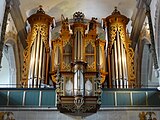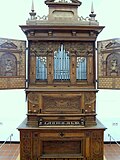Georg Wagner (organ builder)
Georg Wagner (* around 1560; † 1635 in Lich ) was a German organ builder who worked in Hesse around 1600 .
Life
It is unlikely that Georg Wagner is identical to Jorge (Jorg, Görg) Wagner the boy. Jorge was named in a Licher citizen list as early as 1548 and between 1551 and 1571 he can be traced back to the “Urgelmacher”. Presumably he was Georg Wagner's father. Georg's brother Theodor (Dietrich) Wagner (* 1548) is documented between 1575 and 1630 as organist, second pastor and later dean at the Marienstiftskirche Lich . His son Eberhard was also an organ builder and supported his father.
Georg Wagner probably learned the organ trade from Caspar Schütz in Laubach . South German influences suggest further years of apprenticeship in the Main Franconian area. In 1590 at the latest he became organist at the Marienstift and married in 1592. He took over or founded a workshop in Lich and, together with his son Georg Henrich Wagner, shaped the organ landscape of Hesse for a whole century through new buildings, conversions and repair work. Georg Wagner died of the plague in Lich in 1635.
plant
Wagner's works are among the oldest surviving organs in Hessen. He is considered the leading Hessian organ builder in the 17th century. Stylistically, his works range from the late Renaissance to the early Baroque. In addition to small positives, he also created some two- and three-manual works as well as stringed keyboard instruments (clavichords and harpsichords). In 1590 he made his first appearance as an organ builder with an (expansion) renovation in Lich. The "Althefer-Positiv", which is ascribed to him and is known today as the Marburg Castle Organ, has achieved international fame. The unique Renaissance organ was probably built between 1590 and 1600 for the bailiffs Rudolph Wilhelm Rau von Holzhausen and his son-in-law Johann von Bodenhausen from Amönau. After the owner's death, the instrument was transferred to the Wetter collegiate church in 1620 and sold to Friedlos in 1776 . In the 18th century, an extension was made, which, however, led to a deterioration. After the small organ was no longer playable in the course of the 19th century, it was given to the Hessian History Association. He had it set up in Marburg Castle , where it is located today. The instrument originally had six registers , some of which are still original. A reconstruction is currently planned. The high level of craftsmanship in Hesse only finds a contemporary parallel in the von Compenius family of organ builders .
The assignment of the organ in Rodenbach , which bears the year 1621 in the prospectus , is not certain . Here four registers go back to the 17th century. The prospectus in Runkel also shows similarities with Wagner's construction. In the Markuskirche (Butzbach) (1614) and in the Marienstiftskirche Lich (1624) Wagner created medium-sized organs, of which only the brochures have survived. These are among the oldest in Hessen. Both organs are equipped with a Rückpositiv and richly decorated with sawn carvings, as was characteristic of works of the Renaissance. Characteristic are the two-storey flat fields between the pipe towers of the main plant, which have a mirror principle , as you often encounter in Brabant organ building. It is assumed that the organ building family (Bernhard and Johann) Graurock played a mediating role. In Butzbach the prospect pipes are original, while in Lich they were later replaced.
In 1631 Wagner's organ was moved from the Arnsburg monastery to Lich in order to protect it from the Swedish and Hanau troops. With the pedal towers, the organ of the Marienstiftskirche was expanded, which now made a more imposing impression in terms of sound and appearance. In 1638 the Arnsburg abbot asked for the organ back. The Licher initially offered good lead as a replacement, and in 1639 they agreed on a new organ for Arnsburg and that the pedal mechanism should remain in Lich. A new building was ruled out in the medium term due to the war damage in Arnsburg, so that financial compensation was urgently needed, but this did not materialize after 1648. The dispute was even the subject of the Peace of Westphalia and was not finally settled until 1659.
List of works
Italics indicate that the organ has not been preserved or only the historical case has been preserved. In the fifth column, the Roman number indicates the number of manuals , a capital "P" indicates an independent pedal , a lower-case "p" indicates a pedal that is only attached. The Arabic number indicates the number of sounding registers . The last column provides information on the state of preservation or special features.
| year | place | church | image | Manuals | register | Remarks |
|---|---|---|---|---|---|---|
| between 1590 and 1600 | Marburg | Marburg Castle | I. | 6th | "Old yeast positive"; Housing, wind chest and two and a half registers preserved | |
| 1600 | Langgöns | James Church | New construction or renovation; not received | |||
| 1607 | Arnsburg Monastery | Monastery church | II / P | Renovation of the organ; the pedal towers are preserved in Lich | ||
| 1612-1614 | Friedberg | City Church | II | ? +7 | Major repair or remodeling; not received | |
| 1614 | Butzbach | St. Mark's Church | II / p | New building using older parts of the previous organ; Rückpositiv prospectus with principal 2 ′; 1990 New building behind the historical prospectus by Metzler Orgelbau → Organ | ||
| 1620 | Runkel | Protestant church | Attribution; Prospectus with embossed central pipe received | |||
| 1621 | Rodenbach (?) | Ev. church | I. | 8th | Attribution; Prospectus and 4 registers from 1621 (originally built for the town church in Nidda and sold to Rodenbach in 1781?), Later various changes, 1970 restoration by Rudolf von Beckerath | |
| 1621-1624, 1631 | Lich | Marienstiftskirche |

|
II / P | 20th | In 1631 pedal towers from Arnsburg monastery were added; 1972 New building behind the historical prospectus by Förster & Nicolaus Orgelbau (III / P / 33); 5 registers received |
| around 1625 | Pouring (?) | City Church | I / P | 10 (?) | New building; not received | |
| 1625 | Hachenburg | City Church | New building; Replaced in 1716 | |||
| 1626 | Marburg | Parish Church of St. Mary | III / P | 24 | New building; not received | |
| 1628 | Ceiling brook | Ev. church | II / p | 15th | New building with main plant and Rückpositiv; not received | |
| 1633 | Frankfurt am Main | Katharinenkirche (Frankfurt am Main) | Repair of the organ by Lorenz Ettlin (1626/27); not received |
literature
- Gerhard Aumüller : History of the organ from Bad Wildungen in the 16th and 17th centuries. In: Acta Organologica . Vol. 31, 2009, pp. 111-148.
- Hans Martin Balz , Reinhardt Menger: Old organs in Hessen and Nassau (= publication of the Society of Organ Friends . Volume 72 ). 2nd Edition. Merseburger, Kassel 1997, ISBN 3-87537-169-0 .
- Franz Bösken : The organs of the Protestant Marienstiftskirche in Lich (= contributions to the music history of the Middle Rhine . Volume 2 ). Schott, Mainz 1962.
- Franz Bösken: Sources and research on the organ history of the Middle Rhine (= contributions to the Middle Rhine music history . Volume 7.1 ). tape 2 : The area of the former administrative district of Wiesbaden. Part 1: A-K . Schott, Mainz 1975, ISBN 3-7957-1307-2 .
- Franz Bösken: Sources and research on the organ history of the Middle Rhine (= contributions to the Middle Rhine music history . Volume 7.2 ). tape 2 : The area of the former administrative district of Wiesbaden. Part 2: L-Z . Schott, Mainz 1975, ISBN 3-7957-1370-6 .
- Franz Bösken, Hermann Fischer: Sources and research on the organ history of the Middle Rhine. Vol. 3: Former province of Upper Hesse (= contributions to the Middle Rhine music history . Volume 29.1 ). Part 1: A-L . Schott, Mainz 1988, ISBN 3-7957-1330-7 .
- Franz Bösken, Hermann Fischer: Sources and research on the organ history of the Middle Rhine. Vol. 3: Former province of Upper Hesse (= contributions to the Middle Rhine music history . Volume 29.2 ). Part 2: M-Z . Schott, Mainz 1988, ISBN 3-7957-1331-5 .
- Dieter Großmann: Organs and Organ Builders in Hesse (= contributions to Hessian history . Volume 12 ). 2nd Edition. Trautvetter & Fischer, Marburg 1998, ISBN 3-87822-109-6 .
See also
Individual evidence
- ↑ Bösken: The organs of the Protestant Marienstiftskirche in Lich. 1962, pp. 24-25, 50.
- ↑ Aumüller: History of the organ from Bad Wildungen. 2009, pp. 122, 124.
- ^ Gerhard Aumüller , Barbara Uppenkamp: Facts and questions about the origin of the Marburg castle organ . In: Journal of the Association for Hessian History and Regional Studies . Volume 113, 2008, pp. 140 f. ( online ), (PDF file; 630 kB), accessed on March 30, 2017.
- ↑ Bösken: The organs of the Protestant Marienstiftskirche in Lich. 1962, pp. 52-54.
- ↑ For a catalog raisonné see Gerhard Aumüller, Barbara Uppenkamp: Facts and questions about the origin of the Marburg castle organ . In: Journal of the Association for Hessian History and Regional Studies . Volume 113, 2008, p. 146 ( online , accessed March 30, 2017) (PDF file; 630 kB).
- ^ Gerhard Aumüller, Barbara Uppenkamp: Facts and questions about the origin of the Marburg castle organ . In: Journal of the Association for Hessian History and Regional Studies . Volume 113, 2008, pp. 152-164 ( online , accessed March 30, 2017) (PDF file; 630 kB).
- ↑ The historic Marburg Castle Organ (PDF file; 104 kB), accessed on March 30, 2017.
- ^ Bösken, Fischer: Sources and research on the organ history of the Middle Rhine. Vol. 3, Part 2: M-Z. 1988, pp. 804-806.
- ^ Bösken, Fischer: Sources and research on the organ history of the Middle Rhine. Vol. 3, Part 1: A – L. 1988, pp. 167, 215.
- ^ Bösken, Fischer: Sources and research on the organ history of the Middle Rhine. Vol. 3, Part 1: A – L. 1988, p. 606.
- ^ Bösken, Fischer: Sources and research on the organ history of the Middle Rhine. Vol. 3, Part 1: A – L. 1988, p. 73.
- ^ Bösken: Sources and research on the organ history of the Middle Rhine. Vol. 1. 1967, p. 29.
- ↑ According to Hildegard Schmidt, the main works prospectus in Rockenberg / St. Gallus back on Wagner: Catholic parish St. Gallus Rockenberg (Ed.): 250 years of St. Gallus Rockenberg. A parish through the ages. 1754-2004. Rockenberg 2004, pp. 227-231.
- ^ Bösken: Sources and research on the organ history of the Middle Rhine. Vol. 2, Part 1: A – K. 1975, p. 390.
- ^ Bösken: Sources and research on the organ history of the Middle Rhine. Vol 2, Part. 1: A-K . 1975, p. 282.
| personal data | |
|---|---|
| SURNAME | Wagner, Georg |
| BRIEF DESCRIPTION | Hessian organ builder |
| DATE OF BIRTH | around 1560 |
| DATE OF DEATH | 1635 |
| Place of death | Lich |


